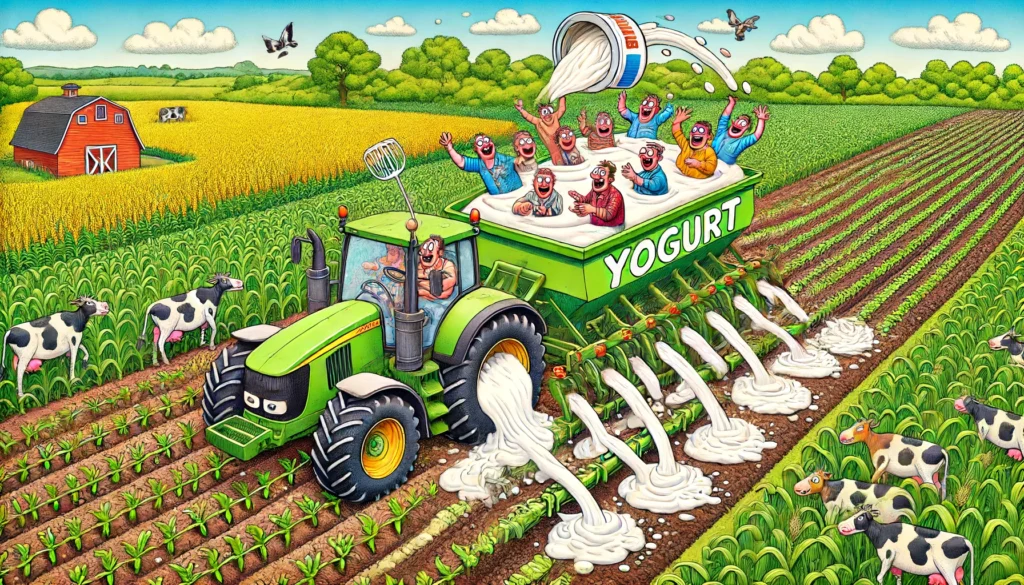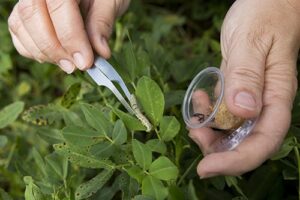
Farmer Cowboy A humorous and detailed illustration in a cartoon style. A farm scene where a tractor with a modified manure spreader is spreading yogurt inst6.webp.webp
The Great Yogurt Spread: Farming’s Dairy Future
Nitrospirillum amazonense and Azospirillum brasilense
Nitrospirillum amazonense and Azospirillum brasilense: The Fertilizers of the Future
Nitrospirillum amazonense and Azospirillum brasilense are revolutionizing sustainable agriculture as the fertilizers of the future. These nitrogen-fixing bacteria naturally enrich soil, enhancing plant growth and productivity without the environmental downsides of chemical fertilizers. By converting atmospheric nitrogen into a usable form for plants, they reduce the need for synthetic nitrogen fertilizers, lowering greenhouse gas emissions and soil degradation. Additionally, these biofertilizers promote healthier root systems and increase crop resilience. Their use aligns with global sustainability goals, offering a green, efficient, and cost-effective solution for modern farming. Embrace the future with biofertilizers for a healthier planet.
A New Dawn in Agriculture
In the year 2025, farming has taken a deliciously unexpected turn. The era of mineral fertilizers is ending, and farmers across the globe are embracing a new, dairy-fueled future. Gone are the days of spreading chemical concoctions over fields; instead, a new hero has emerged from the dairy aisle—yogurt. Yes, you read that right. Yogurt, laced with the super-bacteria Nitrospirillum amazonense and Azospirillum brasilense, is now the fertilizer of choice. And with this revolution, yogurt spreaders are flying off the shelves faster than you can say “probiotic.”
The Yogurt Boom
It all started with a humble experiment in Brazil, where BP Bunge Bioenergia decided to replace mineral fertilizers with bioinputs. Nitrospirillum amazonense and Azospirillum brasilense were the bacterial stars of this new agricultural show, fixing nitrogen in the soil and boosting crop productivity. The results were nothing short of spectacular. Fields flourished, yields skyrocketed, and the cows were very confused. Word spread faster than wildfire, and soon farmers everywhere were trading in their traditional fertilizers for tubs of yogurt.
Breakfast in the Fields
Imagine driving past a farm and seeing cows lined up along the fence, staring longingly at fields covered in yogurt. The cows think breakfast is being served, but little do they know, it’s all part of a grand plan to revolutionize agriculture. Farmers have had to put up signs: “Not for Cow Consumption—Probiotic Fertilizer in Use!” It’s a small price to pay for the benefits that Nitrospirillum amazonense and Azospirillum brasilense bring to the table—or rather, to the field.
The Science Behind the Spread
Let’s talk about the real stars of this story—Nitrospirillum amazonense and Azospirillum brasilense. These bacteria are like personal trainers for plants. Nitrospirillum amazonense helps fix nitrogen in the soil, making it readily available for plants to absorb. This boosts growth and productivity, turning ordinary crops into superplants. Azospirillum brasilense, on the other hand, enhances root development and increases the plant’s ability to absorb water and nutrients. Together, they form a dream team that’s transforming farming from the ground up.
Yogurt Spreaders: The New Must-Have
With the rise of yogurt fertilization, yogurt spreaders have become the latest must-have farming equipment. Agricultural expos now feature booths showcasing the latest in yogurt distribution technology. Forget crop dusters; the future is all about precision yogurt application. Farmers are debating the best yogurt brands to use—should they go Greek, plain, or perhaps a fruity blend for that extra zing? The scientific community is eagerly awaiting the results of these delicious experiments.
Probiotic Powerhouses
The shift to yogurt-based fertilizers isn’t just about novelty; it’s about sustainability and efficiency. Nitrospirillum amazonense and Azospirillum brasilense are natural nitrogen fixers, reducing the need for synthetic fertilizers. This not only cuts down on chemical runoff but also promotes healthier soil and plants. It’s a win-win situation, except maybe for the cows, who are still waiting for their breakfast.
From Field to Fork
The benefits of yogurt-based fertilizers are felt all the way from the field to the dining table. Crops grown with these probiotics are healthier, more robust, and, according to some taste tests, even more delicious. It’s the ultimate farm-to-fork experience. Imagine biting into a salad and knowing that the lettuce was nourished with the same bacteria that keep your gut healthy. It’s a connection to your food that’s almost too wholesome to handle.
The Great Yogurt Debate
Of course, not everyone is on board with the yogurt revolution. Traditionalists argue that mineral fertilizers are tried and true, and switching to yogurt is just a passing fad. But the results speak for themselves. Fields treated with Nitrospirillum amazonense and Azospirillum brasilense are outpacing those using conventional methods. The Great Yogurt Debate rages on in agricultural circles, with farmers passionately discussing the merits of different yogurt brands and bacterial strains.
The Environmental Impact
One of the biggest advantages of yogurt-based fertilizers is their positive impact on the environment. Reducing reliance on chemical fertilizers means less pollution and healthier ecosystems. The use of Nitrospirillum amazonense and Azospirillum brasilense promotes a more sustainable approach to farming, aligning perfectly with global efforts to combat climate change and preserve natural resources.
Cows in the Crossfire
While the shift to yogurt fertilizers is largely positive, there have been some unintended consequences. Cows, confused by the sight and smell of yogurt-covered fields, have been known to wander into areas they shouldn’t. Farmers have had to install extra fencing and signage to keep their bovine friends from indulging in the new fertilizer. It’s a small price to pay for the environmental benefits, but it’s also led to some humorous encounters. One farmer reported finding his cows attempting to “graze” on a freshly fertilized field, only to end up with yogurt-covered snouts.
The Future of Farming
As we look to the future, it’s clear that Nitrospirillum amazonense and Azospirillum brasilense are here to stay. These bacteria represent a new era in agriculture—one that prioritizes sustainability, efficiency, and a touch of humor. The image of farmers spreading yogurt over their fields might seem absurd, but it’s a testament to human ingenuity and the ever-evolving nature of farming.
A Recipe for Success
The success of BP Bunge Bioenergia’s initiative has shown that sometimes the most innovative solutions come from the most unexpected places. By harnessing the power of probiotics, farmers are paving the way for a greener, more sustainable future. The next time you enjoy a bowl of yogurt, take a moment to appreciate the tiny bacteria that are making big waves in agriculture. They’re not just good for your gut—they’re good for the planet.
Conclusion: Raising a Spoon to the Future
The story of yogurt-based fertilizers is a reminder that innovation often comes from thinking outside the box—or in this case, outside the tub. Nitrospirillum amazonense and Azospirillum brasilense are transforming agriculture in ways we never imagined. As farmers continue to embrace this dairy-fueled future, we can all raise a spoon to the ingenuity and humor that make these advancements possible. Here’s to a future where fields flourish, cows stay curious, and yogurt reigns supreme.
Auf Wiedersehen
This story is a delightful collaboration between two sentient beings—a cowboy and a farmer. Any resemblance to real events or actual bacteria is purely coincidental, though highly probable given the current agricultural trends. No AI were harmed in the writing of this satire, and any yogurt mentioned is purely fictional, though it might exist in your local grocery store. Enjoy your sustainable farming, save the planet, and remember to laugh along the way. Auf Wiedersehen!
Originally Published at FarmerCowboy.com
2024-06-13 13:11:35
Originally posted 2024-06-15 07:41:03.
Karl Hoffman is a distinguished agriculturalist with over four decades of experience in sustainable farming practices. He holds a Ph.D. in Agronomy from Cornell University and has made significant contributions as a professor at Iowa State University. Hoffman’s groundbreaking research on integrated pest management and soil health has revolutionized modern agriculture. As a respected farm journalist, his column “Field Notes with Karl Hoffman” and his blog “The Modern Farmer” provide insightful, practical advice to a global audience. Hoffman’s work with the USDA and the United Nations FAO has enhanced food security worldwide. His awards include the USDA’s Distinguished Service Award and the World Food Prize, reflecting his profound impact on agriculture and sustainability.










